Description

Old Courthouse and Jail, Buffalo
BUILT TO REPLACE THE COURTHOUSE DESTROYED WHEN BUFFALO WAS BURNED BY THE BRITISH IN 1813, construction on the Old Courthouse and Jail began in 1816 and was completed the following year. At that time, the structure was considered to be among the finest public buildings in Western New York. The two-story brick building had a front porch and large pillars that extended up to the cornice. A portion of the first floor was occupied by the County Clerk’s office. Although the facility was expanded and improved, the deteriorating condition of the building was recognized, and in 1849 the State Assembly authorized that yet another facility be erected at a cost of $17,000. This brick, three floor courthouse was bounded by Washington, Batavia, Ellicott and Clinton Streets, the site of the present Buffalo and Erie County Public Library, and was used for 25 years in conjunction with its predecessor to conduct court business. The Old Courthouse was abandoned March 11, 1876.
Source: Jeannine A. Lee, Senior Law Librarian, Supreme Court Library, Buffalo, N.Y
CITY AND COUNTY HALL
DESIGNED BY ROCHESTER ARCHITECT ANDREW JACKSON WARNER, CITY AND COUNTY HALL OPENED ITS DOORS ON MARCH 13, 1876. Housing judges and members of the Bar as well as city and county offices, Erie County’s fourth courthouse was built at an approximate cost of $1,200,000. The Norman Gothic style granite building is located at 92 Franklin Street. It was here that Grover Cleveland had his office when he served as Mayor of Buffalo in 1881, and on September 17, 1901, William McKinley lay in state following his assassination. The trial of President McKinley’s assassin, Leon Czolgosz, took place here in Part 3 in Criminal Term of Supreme Court. As overcrowding became an issue, city government relocated, leaving Old County Hall, as it is now known, to house county agencies and court operations.
The building showcases a 268 foot bell tower complete with a clock whose four dials measure 19 feet in diameter. The faces are fabricated of white translucent plastic for nighttime illumination, following the design of ‘Big Ben,’ the clock of the British Houses of Parliament. The pendulum is 15 feet long and is enclosed to protect it from wind and blowing dust. The bell itself weighs 4400 lbs, and the entire clock system from the bell to the top of the dials measures approximately 58 feet and extends through four floors of the tower. Four granite statues of women, sculpted by Giovanni F. Sala, adorn each corner of the tower, representing Justice, Mechanic Arts, Agriculture and Commerce. The statues cost $22,000 each, stand 16 feet tall and weigh 14 tons.
Sources: Hon. Sheila A. DiTullio, Erie County Court Judge, Buffalo, N.Y.; Jeannine A. Lee, Senior Law Librarian, Supreme Court Library, Buffalo, N.Y.
February 2006

Monroe County Courthouse and City Hall, Rochester
MONROE COUNTY, NAMED FOR PRESIDENT JAMES MONROE, WAS CREATED FROM PORTIONS OF ONTARIO AND GENESEE COUNTIES ON FEBRUARY 23, 1821. The first Board of Supervisors met in taverns or borrowed space in City Hall until a county courthouse could be built. The cornerstone for the first courthouse was laid on September 4, 1821 on land donated by founding fathers Nathaniel Rochester, Charles Carroll and William Fitzhugh. A second courthouse was built on the same site but was razed when it became too small to accommodate the county courts and offices. The third courthouse, begun in 1894, currently serves as the County Office Building and is a unique example of the Italianate style of architecture, a style not frequently seen in public buildings. The building’s impressive marble staircase still inspires those who enter. The second floor offers visitors the chance to see the original millstones from Allan’s mill, which was established in Rochester by Ebenezer Allan in 1789.
Source: Hon. John J. Connell, Monroe County Court Judge, Rochester, N.Y.
FREDERICK DOUGLASS
AN ESCAPED SLAVE WHO TAUGHT HIMSELF TO READ, ABOLITIONIST FREDERICK DOUGLASS ARRIVED IN MONROE COUNTY IN DECEMBER, 1847. There he began his career as an impassioned newspaper publisher. Douglass’s North Star became the nation’s foremost black-owned newspaper. On its masthead appeared the motto, ‘Right is of no sex – Truth is of no color – God is the father of us all, and we are all Brethren.’ Because of its strategic location near Canada, Douglass’s Rochester home became an important stop on the Underground Railroad through the 1850s. During this time, Douglass played host to a number of fellow abolitionists like Sojourner Truth and William Lloyd Garrison. Rochester’s women were active in the anti-slavery movement, and through them Douglass kept in close contact with the leaders in the fight for women’s rights, including Susan B. Anthony and Elizabeth Cady Stanton. On February 20, 1895, at the age of 77, Douglass died from a massive heart attack. As news of his death spread across the country, crowds gathered at the Washington D.C. church where he lay in state. His wife, Anna, and his children returned to Rochester with his body, where he was laid to rest in Mt. Hope Cemetery.
Source: A Biography of The Life of Frederick Douglass by Sandra Thomas (available at http://www.history.rochester.edu/class/douglass/home.html).
March 2006
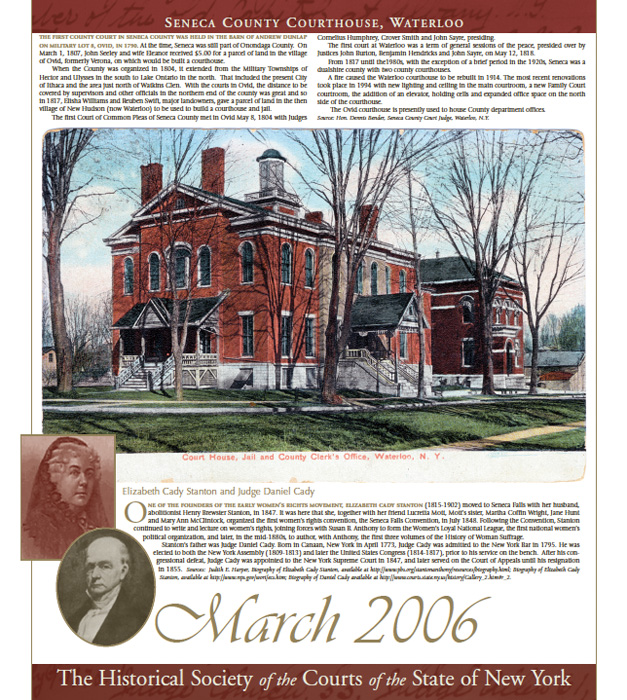
Seneca County Courthouse, Waterloo
THE FIRST COUNTY COURT IN SENECA COUNTY WAS HELD IN THE BARN OF ANDREW DUNLAP ON MILITARY LOT 8, OVID, IN 1790. At the time, Seneca was still part of Onondaga County. On March 1, 1807, John Seeley and wife Eleanor received $5.00 for a parcel of land in the village of Ovid, formerly Verona, on which would be built a courthouse. When the County was organized in 1804, it extended from the Military Townships of Hector and Ulysses in the south to Lake Ontario in the north. That included the present City of Ithaca and the area just north of Watkins Glen. With the courts in Ovid, the distance to be covered by supervisors and other officials in the northern end of the county was great and so in 1817, Elisha Williams and Reuben Swift, major landowners, gave a parcel of land in the then village of New Hudson (now Waterloo) to be used to build a courthouse and jail. The first Court of Common Pleas of Seneca County met in Ovid May 8, 1804 with Judges Cornelius Humphrey, Grover Smith and John Sayre, presiding. The first court at Waterloo was a term of general sessions of the peace, presided over by Justices John Burton, Benjamin Hendricks and John Sayre, on May 12, 1818. From 1817 until the1980s, with the exception of a brief period in the 1920s, Seneca was a dualshire county with two county courthouses. A fire caused the Waterloo courthouse to be rebuilt in 1914. The most recent renovations took place in 1994 with new lighting and ceiling in the main courtroom, a new Family Court courtroom, the addition of an elevator, holding cells and expanded office space on the north side of the courthouse. The Ovid courthouse is presently used to house County department offices.
Source: Hon. Dennis Bender, Seneca County Court Judge, Waterloo, N.Y.
ELIZABETH CADY STANTON AND JUDGE DANIEL CADY
ONE OF THE FOUNDERS OF THE EARLY WOMEN’S RIGHTS MOVEMENT, ELIZABETH CADY STANTON (1815-1902) moved to Seneca Falls with her husband, abolitionist Henry Brewster Stanton, in 1847. It was here that she, together with her friend Lucretia Mott, Mott’s sister, Martha Coffin Wright, Jane Hunt and Mary Ann McClintock, organized the first women’s rights convention, the Seneca Falls Convention, in July 1848. Following the Convention, Stanton continued to write and lecture on women’s rights, joining forces with Susan B. Anthony to form the Women’s Loyal National League, the first national women’s political organization, and later, in the mid-1880s, to author, with Anthony, the first three volumes of the History of Woman Suffrage. Stanton’s father was Judge Daniel Cady. Born in Canaan, New York in April 1773, Judge Cady was admitted to the New York Bar in 1795. He was elected to both the New York Assembly (1809-1813) and later the United States Congress (1814-1817), prior to his service on the bench. After his congressional defeat, Judge Cady was appointed to the New York Supreme Court in 1847, and later served on the Court of Appeals until his resignation in 1855.
Sources: Judith E. Harper, Biography of Elizabeth Cady Stanton, available at http://www.pbs.org/stantonanthony/resources/biography.html; Biography of Elizabeth Cady Stanton, available at http://www.nps.gov/wori/ecs.htm; Biography of Daniel Cady available at http://www.courts.state.ny.us/history/Gallery_2.htm#r_2.
April 2006
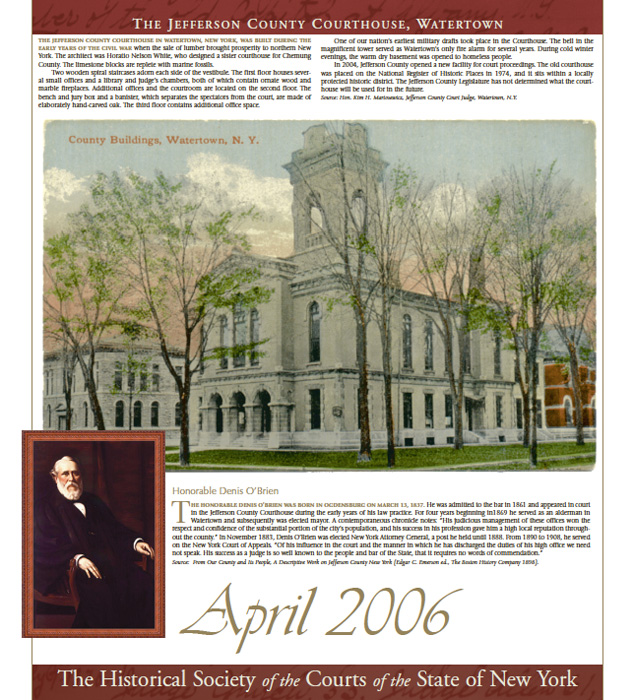
The Jefferson County Courthouse, Watertown
THE JEFFERSON COUNTY COURTHOUSE IN WATERTOWN, NEW YORK, WAS BUILT DURING THE EARLY YEARS OF THE CIVIL WAR when the sale of lumber brought prosperity to northern New York. The architect was Horatio Nelson White, who designed a sister courthouse for Chemung County. The limestone blocks are replete with marine fossils. Two wooden spiral staircases adorn each side of the vestibule. The first floor houses several small offices and a library and judge’s chambers, both of which contain ornate wood and marble fireplaces. Additional offices and the courtroom are located on the second floor. The bench and jury box and a banister, which separates the spectators from the court, are made of elaborately hand-carved oak. The third floor contains additional office space. One of our nation’s earliest military drafts took place in the Courthouse. The bell in the magnificent tower served as Watertown’s only fire alarm for several years. During cold winter evenings, the warm dry basement was opened to homeless people. In 2004, Jefferson County opened a new facility for court proceedings. The old courthouse was placed on the National Register of Historic Places in 1974, and it sits within a locally protected historic district. The Jefferson County Legislature has not determined what the courthouse will be used for in the future.
Source: Hon. Kim H. Martosewicz, Jefferson County Court Judge, Watertown, N.Y.
HONORABLE DENIS O’BRIEN
THE HONORABLE DENIS O’BRIEN WAS BORN IN OGDENSBURG ON MARCH 13, 1837. He was admitted to the bar in 1861 and appeared in court in the Jefferson County Courthouse during the early years of his law practice. For four years beginning in1869 he served as an alderman in Watertown and subsequently was elected mayor. A contemporaneous chronicle notes: ‘His judicious management of these offices won the respect and confidence of the substantial portion of the city’s population, and his success in his profession gave him a high local reputation throughout the county.’ In November 1883, Denis O’Brien was elected New York Attorney General, a post he held until 1888. From 1890 to 1908, he served on the New York Court of Appeals. ‘Of his influence in the court and the manner in which he has discharged the duties of his high office we need not speak. His success as a judge is so well known to the people and bar of the State, that it requires no words of commendation.’
Source: From Our County and Its People, A Descriptive Work on Jefferson County New York (Edgar C. Emerson ed., The Boston History Company 1898).
May 2006

Oneida County Courthouse, Utica
THE ONEIDA COUNTY COURTHOUSE WILL BE CELEBRATING ITS 100TH ANNIVERSARY IN 2007 OR 2008. It is unclear which year is the proper date because the building was completed in 1907 but not furnished until 1908. The building was to cost $250,000 to construct but actually cost nearly $1 million upon completion. After several renovations that tarnished its external and internal beauty, it is now receiving a rehabilitation that will restore a main courtroom and the beautifully coffered ceiling that comprise the third-floor. This work is scheduled to be complete in time for the 100th anniversary celebration. The building once housed both county government and the courts. It is currently occupied by all courts except City Court.
Source: Hon. Barry M. Donalty, Supreme Court Justice by Designation, Utica, N.Y.
ROSCOE CONKLING
BOTH AS CONGRESSMAN AND UNITED STATES SENATOR, UTICA NATIVE ROSCOE CONKLING WAS A MAJOR CONTRIBUTOR TO THE ANTISLAVERY MOVEMENT. Conkling served in the House of Representatives from 1858 to 1862 and from1864 to 1867, and in the United States Senate from 1867 to 1881. During his service in the House, he sponsored key anti-slavery legislation at President Lincoln’s request and was a key leader in defeating the drive to deny Lincoln’s re-nomination. As a United States Senator he was a leading advocate of the crucial anti-inflation policies of that era. Even though the position of Majority Leader did not exist, he was generally regarded as the Master of the Senate during Ulysses S. Grant’s presidency. In 1873, Conkling famously rejected Grant’s written offer to nominate him to be Chief Justice of the United States Supreme Court. In 1880, President Chester A. Arthur nominated Conkling to be Associate Justice of the Supreme Court, without Conkling’s knowledge, on a Monday with confirmation by the Senate two days later. When actually notified two days thereafter, he promptly declined, later explaining both rejections stating, ‘I would forever be gnawing at my chains.’ Conkling resigned from the Senate because of a dispute with President James A. Garfield. He practiced law in New York City and maintained his home, which still stands, on Rutger Street in Utica, New York.
Source: Hon. Barry M. Donalty, Supreme Court Justice by Designation, Utica, N.Y.
June 2006
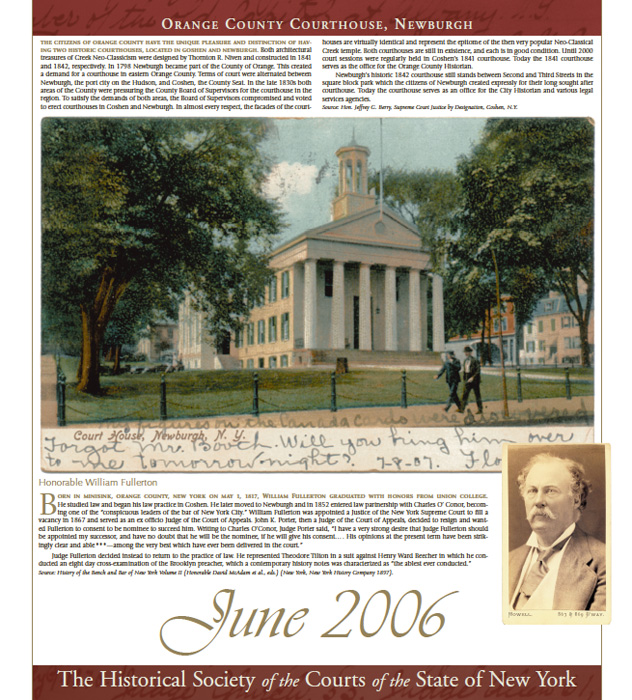
Orange County Courthouse, Newburgh
THE CITIZENS OF ORANGE COUNTY HAVE THE UNIQUE PLEASURE AND DISTINCTION OF HAVING TWO HISTORIC COURTHOUSES, LOCATED IN GOSHEN AND NEWBURGH. Both architectural treasures of Greek Neo-Classicism were designed by Thornton R. Niven and constructed in 1841 and 1842, respectively. In 1798 Newburgh became part of the County of Orange. This created a demand for a courthouse in eastern Orange County. Terms of court were alternated between Newburgh, the port city on the Hudson, and Goshen, the County Seat. In the late 1830s both areas of the County were pressuring the County Board of Supervisors for the courthouse in the region. To satisfy the demands of both areas, the Board of Supervisors compromised and voted to erect courthouses in Goshen and Newburgh. In almost every respect, the facades of the courthouses are virtually identical and represent the epitome of the then very popular Neo-Classical Greek temple. Both courthouses are still in existence, and each is in good condition. Until 2000 court sessions were regularly held in Goshen’s 1841 courthouse. Today the 1841 courthouse serves as the office for the Orange County Historian. Newburgh’s historic 1842 courthouse still stands between Second and Third Streets in the square block park which the citizens of Newburgh created expressly for their long sought after courthouse. Today the courthouse serves as an office for the City Historian and various legal services agencies.
Source: Hon. Jeffrey G. Berry, Supreme Court Justice by Designation, Goshen, N.Y.
HONORABLE WILLIAM FULLERTON
BORN IN MINISINK, ORANGE COUNTY, NEW YORK ON MAY 1, 1817, WILLIAM FULLERTON GRADUATED WITH HONORS FROM UNION COLLEGE. He studied law and began his law practice in Goshen. He later moved to Newburgh and in 1852 entered law partnership with Charles O’Conor, becoming one of the ‘conspicuous leaders of the bar of New York City.’ William Fullerton was appointed a Justice of the New York Supreme Court to fill a vacancy in 1867 and served as an ex officio Judge of the Court of Appeals. John K. Porter, then a Judge of the Court of Appeals, decided to resign and wanted Fullerton to consent to be nominee to succeed him. Writing to Charles O’Conor, Judge Porter said, ‘I have a very strong desire that Judge Fullerton should be appointed my successor, and have no doubt that he will be the nominee, if he will give his consent. His opinions at the present term have been strikingly clear and able-among the very best which have ever been delivered in the court.’
Judge Fullerton decided instead to return to the practice of law. He represented Theodore Tilton in a suit against Henry Ward Beecher in which he conducted an eight day cross-examination of the Brooklyn preacher, which a contemporary history notes was characterized as ‘the ablest ever conducted.’
Source: History of the Bench and Bar of New York Volume II (Honorable David McAdam et al., eds.) (New York, New York History Company 1897).
July 2006
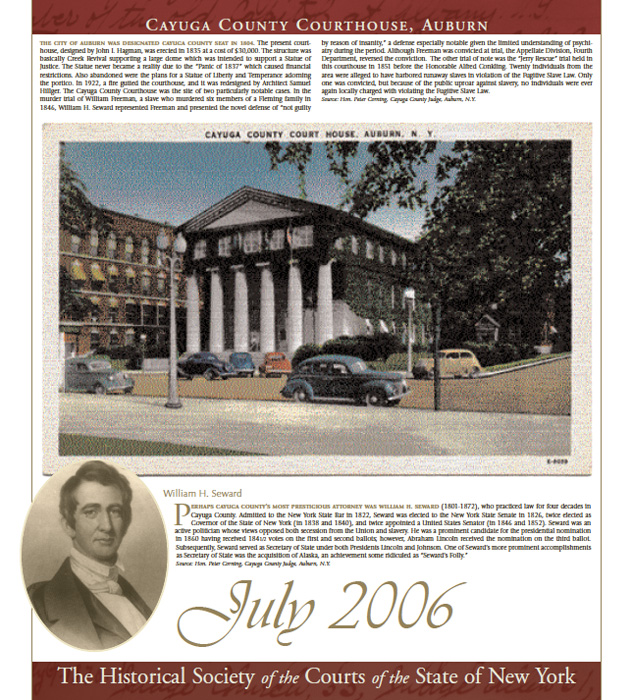
Cayuga County Courthouse, Albion
THE CITY OF AUBURN WAS DESIGNATED CAYUGA COUNTY SEAT IN 1804. The present courthouse, designed by John I. Hagman, was erected in 1835 at a cost of $30,000. The structure was basically Greek Revival supporting a large dome which was intended to support a Statue of Justice. The Statue never became a reality due to the ‘Panic of 1837’ which caused financial restrictions. Also abandoned were the plans for a Statue of Liberty and Temperance adorning the portico. In 1922, a fire gutted the courthouse, and it was redesigned by Architect Samuel Hillger. The Cayuga County Courthouse was the site of two particularly notable cases. In the murder trial of William Freeman, a slave who murdered six members of a Fleming family in 1846, William H. Seward represented Freeman and presented the novel defense of ‘not guilty by reason of insanity,’ a defense especially notable given the limited understanding of psychiatry during the period. Although Freeman was convicted at trial, the Appellate Division, Fourth Department, reversed the conviction. The other trial of note was the ‘Jerry Rescue’ trial held in this courthouse in 1851 before the Honorable Alfred Conkling. Twenty individuals from the area were alleged to have harbored runaway slaves in violation of the Fugitive Slave Law. Only one was convicted, but because of the public uproar against slavery, no individuals were ever again locally charged with violating the Fugitive Slave Law.
Source: Hon. Peter Corning, Cayuga County Judge, Auburn, N.Y.
WILLIAM H. SEWARD
PERHAPS CAYUGA COUNTY’S MOST PRESTIGIOUS ATTORNEY WAS WILLIAM H. SEWARD (1801-1872), who practiced law for four decades in Cayuga County. Admitted to the New York State Bar in 1822, Seward was elected to the New York State Senate in 1826, twice elected as Governor of the State of New York (in 1838 and 1840), and twice appointed a United States Senator (in 1846 and 1852). Seward was an active politician whose views opposed both secession from the Union and slavery. He was a prominent candidate for the presidential nomination in 1860 having received 1841/2 votes on the first and second ballots; however, Abraham Lincoln received the nomination on the third ballot. Subsequently, Seward served as Secretary of State under both Presidents Lincoln and Johnson. One of Seward’s more prominent accomplishments as Secretary of State was the acquisition of Alaska, an achievement some ridiculed as ‘Seward’s Folly.’
Source: Hon. Peter Corning, Cayuga County Judge, Auburn, N.Y. August 2006
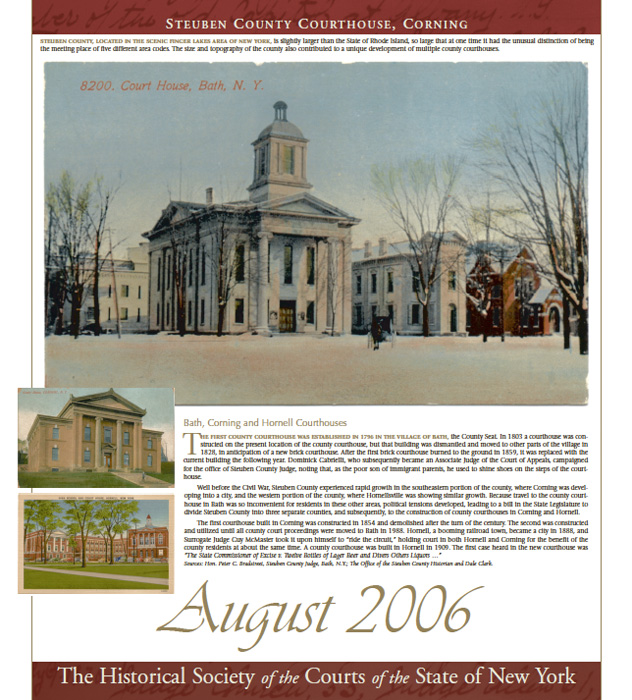
Steuben County Courthouse, Corning
STEUBEN COUNTY, LOCATED IN THE SCENIC FINGER LAKES AREA OF NEW YORK, is slightly larger than the State of Rhode Island, so large that at one time it had the unusual distinction of being the meeting place of five different area codes. The size and topography of the county also contributed to a unique development of multiple county courthouses.
BATH, CORNING AND HORNELL COURTHOUSES
THE FIRST COUNTY COURTHOUSE WAS ESTABLISHED IN 1796 IN THE VILLAGE OF BATH, the County Seat. In 1803 a courthouse was constructed on the present location of the county courthouse, but that building was dismantled and moved to other parts of the village in 1828, in anticipation of a new brick courthouse. After the first brick courthouse burned to the ground in 1859, it was replaced with the current building the following year. Dominick Gabrielli, who subsequently became an Associate Judge of the Court of Appeals, campaigned for the office of Steuben County Judge, noting that, as the poor son of immigrant parents, he used to shine shoes on the steps of the courthouse.
Well before the Civil War, Steuben County experienced rapid growth in the southeastern portion of the county, where Corning was developing into a city, and the western portion of the county, where Hornellsville was showing similar growth. Because travel to the county courthouse in Bath was so inconvenient for residents in these other areas, political tensions developed, leading to a bill in the State Legislature to divide Steuben County into three separate counties, and subsequently, to the construction of county courthouses in Corning and Hornell.
The first courthouse built in Corning was constructed in 1854 and demolished after the turn of the century. The second was constructed and utilized until all county court proceedings were moved to Bath in 1988. Hornell, a booming railroad town, became a city in 1888, and Surrogate Judge Guy McMaster took it upon himself to ‘ride the circuit,’ holding court in both Hornell and Corning for the benefit of the county residents at about the same time. A county courthouse was built in Hornell in 1909. The first case heard in the new courthouse was ‘The State Commissioner of Excise v. Twelve Bottles of Lager Beer and Divers Others Liquors’
Sources: Hon. Peter C. Bradstreet, Steuben County Judge, Bath, N.Y.; The Office of the Steuben County Historian and Dale Clark.
September 2006

Tioga County Courthouse, Owego
IN 1868 CAME THE FIRST OFFICIAL RESPONSE THAT A NEW COURTHOUSE IN TIOGA COUNTY MIGHT BE IN ORDER. A Tioga County Grand Jury returned an indictment against the existing courthouse charging that it was ‘unsuitable and inconvenient for transaction of legal business.’ In 1870, the Board of Supervisors approved the building of a new courthouse and appropriated $5,000 toward construction costs.
The laying of the cornerstone on August 1, 1871 was attended by thousands of people and was one of the greatest single celebrations in Tioga County history. Special trains began arriving in Owego at 9:30 in the morning. A parade that stretched for a mile ended at 1:30 p.m. Speeches lasted until 5:30 p.m., after which the crowd dispersed to seven hotels and three restaurants for a special banquet.
The bill of fare consisted of broiled corned beef and tongue; roast beef, lamb, veal and pig; a baked veal pie as a side dish; corn, turnips, potatoes, green peas, beets, string beans, onions and squash; relishes of cucumbers, tomatoes and coleslaw; lemon, apple and blackberry pie, tapioca pudding and for dessert melons, peaches and vanilla ice cream.
Two toasts followed the banquet and dancing continued until 4:00 a.m. the following day. Any doubts that the Village may have had about the new courthouse must have been dispelled by the festivities that attended the first day of construction.
As with many buildings and construction projects that are completed today, there were cost over-runs. When the building was finished in the summer of 1873, the total cost, including furnishings, came to $65,000. The building has been well worth the original investment, however. It has served the people of Tioga County for over 100 years and should do so for many years to come.
Source: Hon. Vincent Sgueglia, Tioga County Judge, Owego, N.Y.
PRESIDING JUSTICE CHARLES E. PARKER
PRESIDING JUSTICE CHARLES E. PARKER (1836-1909) WAS BORN IN OWEGO IN TIOGA COUNTY. His father, John M. Parker, was a member of Congress and Justice of the New York Supreme Court. His grandfather, John C. Parker, was also a judge. Presiding Justice Parker graduated from Hobart College in 1857. He read law with his father, was admitted to the bar in 1859 and, after a year of practice in Elmira, returned to Owego. In 1867, he was appointed United States Commissioner for the Northern District of New York and in the same year was elected a member of the State Constitutional Convention. At various times in the 1870s, he was President of the Village of Owego. He was elected County and Surrogate Judge of Tioga County in 1883. He was elected to the Supreme Court in 1887 and reelected in 1901. He was appointed Presiding Justice of the Third Department in October 1895 and served as such until he retired in January, 1907. Presiding Justice Parker was said to be quite eccentric in manner. He had great scorn for fashion and modish clothing, and it took considerable urging on the part of his colleagues on the bench to induce him to wear the robe of a justice. He was very interested in scientific agriculture and owned and operated a large farm near Owego.
Source: Hon. Vincent Sgueglia, Tioga County Judge, Owego, N.Y.
October 2006

The Lawrence H. Cooke Sullivan County Courthouse, Monticello
THE ORIGINAL SULLIVAN COUNTY COURTHOUSE, A WOODEN STRUCTURE, WAS DESTROYED BY FIRE ON JANUARY 13, 1844. The blaze started, according to early accounts, when a fire at a neighboring residence spread to the wooden courthouse. The new stone structure, built by Orange County resident Samuel Bull, was completed in November 1845 at a cost of $6,790, well below the $8,000 originally estimated. The new courthouse was designed in the Federal style because it was thought Greek Revival architecture was losing favor among Americans. The structure was replaced by the current sandstone courthouse in 1909 because the cost of enlarging and repairing it would have been greater than the cost of a new building. The courthouse remains on its original site on Broadway. Over the years it has undergone several renovations, and in 1979, the building was converted from a county office building to a courthouse by expanding the facility to accommodate the ever-increasing court dockets.
Source: Hon Frank J. LaBuda, Sullivan Court Judge and Surrogate, Monticello, N.Y.
SULLIVAN COUNTY’S CHIEF JUDGES
MONTICELLO IN SULLIVAN COUNTY HAS PRODUCED TWO OF NEW YORK’S CHIEF JUDGES. Lawrence Henry Cooke, Chief Judge from 1979 to 1984, was born in Monticello, New York on October 15, 1914. He was elected Sullivan County Judge in 1955 and reelected in 1959, elected Supreme Court Justice in 1961, designated to the Appellate Division in 1968 and 1971, elected Associate Judge of the Court of Appeals in 1974 and appointed Chief Judge of the Court of Appeals by Governor Carey in 1979. Judith Smith Kaye was born in Monticello, New York on August 4, 1938. She was appointed Chief Judge by Governor Mario M. Cuomo on February 22, 1993. She is the first woman to occupy the State Judiciary’s highest office. Chief Judge Kaye was appointed to the Court of Appeals by Governor Cuomo, and confirmed by the State Senate in September 1983-the first woman to serve on the State’s highest court. Prior to that appointment, she was for 21 years a trial lawyer with law firms in New York City. She earned her B.A. at Barnard College in 1958 and her LL.B. at New York University School of Law (cum laude) in 1962 and was admitted to the New York State Bar in 1963.
Sources: Hon Frank J. LaBuda, Sullivan Court Judge and Surrogate, Monticello, New York and http://www.courts.state.ny.us/history/Judges.htm.
November 2006
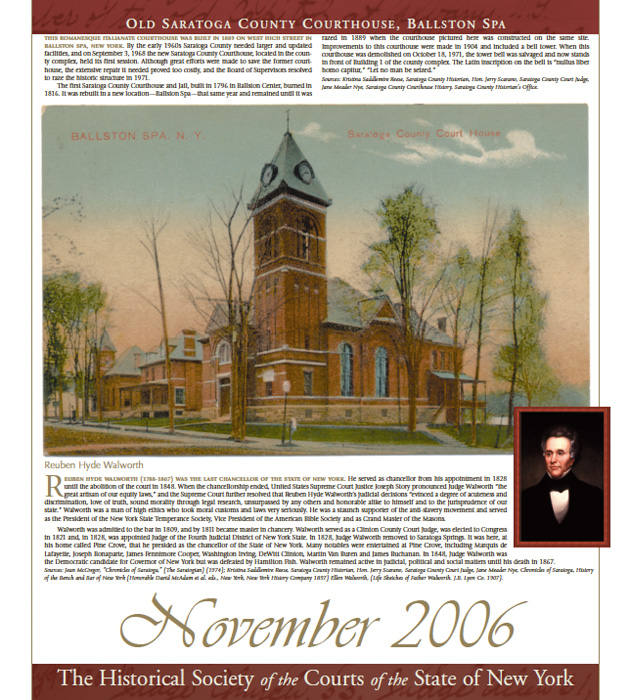
Old Saratoga County Courthouse, Ballston Spa
THIS ROMANESQUE ITALIANATE COURTHOUSE WAS BUILT IN 1889 ON WEST HIGH STREET IN BALLSTON SPA, NEW YORK. By the early 1960s Saratoga County needed larger and updated facilities, and on September 3, 1968 the new Saratoga County Courthouse, located in the county complex, held its first session. Although great efforts were made to save the former courthouse, the extensive repair it needed proved too costly, and the Board of Supervisors resolved to raze the historic structure in 1971. The first Saratoga County Courthouse and Jail, built in 1796 in Ballston Center, burned in 1816. It was rebuilt in a new locationóBallston Spaóthat same year and remained until it was razed in 1889 when the courthouse pictured here was constructed on the same site. Improvements to this courthouse were made in 1904 and included a bell tower. When this courthouse was demolished on October 18, 1971, the tower bell was salvaged and now stands in front of Building 1 of the county complex. The Latin inscription on the bell is ‘nulls liber homo capitur,’ ‘Let no man be seized.’
Sources: Kristina Saddlemire Reese, Saratoga County Historian, Hon. Jerry Scarano, Saratoga County Court Judge, Jane Meader Nye, Saratoga County Courthouse History, Saratoga County Historian’s Office.
REUBEN HYDE WALWORTH
REUBEN HYDE WALWORTH (1788-1867) WAS THE LAST CHANCELLOR OF THE STATE OF NEW YORK. He served as chancellor from his appointment in 1828 until the abolition of the court in 1848. When the chancellorship ended, United States Supreme Court Justice Joseph Story pronounced Judge Walworth ‘the great artisan of our equity laws,’ and the Supreme Court further resolved that Reuben Hyde Walworth’s judicial decisions ‘evinced a degree of acuteness and discrimination, love of truth, sound morality through legal research, unsurpassed by any others and honorable alike to himself and to the jurisprudence of our state.’ Walworth was a man of high ethics who took moral customs and laws very seriously. He was a staunch supporter of the anti-slavery movement and served as the President of the New York State Temperance Society, Vice President of the American Bible Society and as Grand Master of the Masons.
Walworth was admitted to the bar in 1809, and by 1811 became master in chancery. Walworth served as a Clinton County Court Judge, was elected to Congress in 1821 and, in 1828, was appointed Judge of the Fourth Judicial District of New York State. In 1828, Judge Walworth removed to Saratoga Springs. It was here, at his home called Pine Grove, that he presided as the chancellor of the State of New York. Many notables were entertained at Pine Grove, including Marquis de Lafayette, Joseph Bonaparte, James Fennimore Cooper, Washington Irving, DeWitt Clinton, Martin Van Buren and James Buchanan. In 1848, Judge Walworth was the Democratic candidate for Governor of New York but was defeated by Hamilton Fish. Walworth remained active in judicial, political and social matters until his death in 1867.
Sources: Jean McGregor, ‘Chronicles of Saratoga,’ (The Saratogian) (1974); Kristina Saddlemire Reese, Saratoga County Historian, Hon. Jerry Scarano, Saratoga County Court Judge, Jane Meader Nye, Chronicles of Saratoga, History of the Bench and Bar of New York (Honorable David McAdam et al. eds., New York, New York History Company 1897) Ellen Walworth, (Life Sketches of Father Walworth. J.B. Lyon Co. 1907).
December 2006

Franklin County Courthouse, Malone
THE FRANKLIN COUNTY COURTHOUSE, FIRST PROPOSED IN 1930, REMAINS TODAY THE SEAT OF THE TRIAL COURTS IN FRANKLIN COUNTY. For many years, a session of the United States District Court for the Northern District of New York was held here each summer. In one such session, a local jury acquitted the gangster ‘Dutch’ Schultz of federal charges of income tax evasion. The first courthouse on this site was erected by Noah Moody from 1811 to 1813 and included a jail. In 1819 an adjacent county clerk’s office was built, and in 1852, a separate jail was completed. Subsequent construction followed in 1882 and 1893 providing new, separate facilities for the courthouse, county clerk’s office and jail. These served Franklin County until the construction of the present building during the Great Depression.
Sources: Hon. Robert G. Main, Jr., Franklin County Judge, Malone, N.Y. and the records of the Franklin County Clerk.
WILLIAM ALMON WHEELER
WILLIAM ALMON WHEELER WAS BORN IN MALONE, ON JUNE 30, 1819. At the age of 19 he entered the University of Vermont, where he continued for two years. He returned to Malone and studied law for four years and was admitted to the New York bar in 1845. Active in politics, he was town clerk, school commissioner, school inspector and, soon after the adoption of the State Constitution of 1846, became Franklin County District Attorney. He was elected to the State Assembly in 1850 and State Senate in 1858, where he was chosen Presidentpro tempore.
In 1860, Wheeler was elected to Congress and served one term. In 1867 he was chosen a member of the State Constitutional Convention, and when that body assembled he became its president. In 1868 he was again elected to Congress and was three times re-elected in succession. He served as a member of the Committees on Appropriations and Southern Affairs and was chair of the Committees on the Pacific Railroad and Commerce. In 1875 he visited New Orleans and prepared an adjustment for the political difficulties in Louisiana, which became known as the ‘Wheeler Compromise.’
Sources: Hon. Robert G. Main, Jr., Franklin County Judge and http://www.franklinhistory.org.





